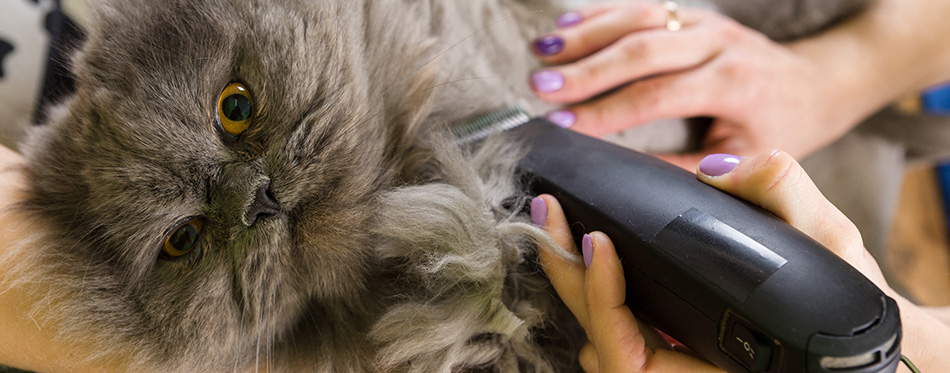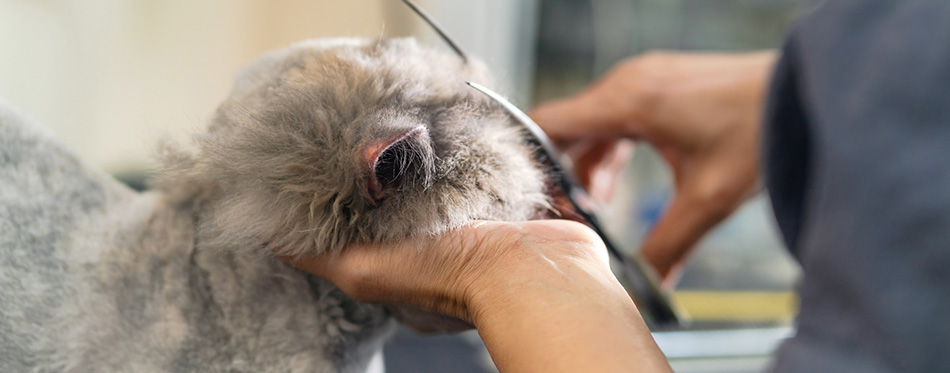One of the reasons why many domestic cats fell out of favor in the past is because of the emergence of long-haired feline breeds. Let’s face it – a long-haired kitty looks more stunning than a short-haired one. However, this is more related to the personal preference of the cat owner. Long haired felines may be elegant to look at, but they require a more meticulous grooming regimen. One minor oversight and your long haired kitty can become a messy ball of tangles and mats. In such cases, you have to get yourself and your tools ready to trim your feline friend. It can be daunting, what with a cat’s sharp claws, teeth, and the general tendency to be averse to grooming. Nevertheless, it is still possible to trim your long haired feline friend in a safe manner.

Always Accustom Your Cat to Trimming Its Hair and Grooming in General
If you got a Persian, Birman, Maine Coon, Ragdoll, or any other long-haired cat breed as a kitten, it’s best to get them accustomed to the grooming process. This will make your life easier as a pet parent of these rambunctious and testy young felines. The thing to remember is that acclimatizing your kitten to the grooming experience will make it feel more at ease every time it has to have a haircut and more thorough grooming.
Since a kitten is already accustomed to how you hold it during grooming, it will never fight you once it grows into an adult. This means you need to introduce the young pet to the tools of the trade as well as the different steps to accomplish the trim.
Always introduce grooming items like a cat brush, pet comb, deshedding brush, and pet hair clipper one at a time. It may also be a good idea to introduce a pair of scissors. Lay these on the floor and let your pet sniff and explore it. What you want is for the young feline to “accept” these items as normal parts of its existence.
Once the young kitten feels comfortable in the presence of these tools, hold them one at a time. Proceed to using these items. One very particular concern is the pet clipper. It is ideal if you can get a clipper that is as quiet as possible. Pets don’t like loud noises.
Suffice it to say, you should also acclimatize your kitten to the feeling of being held in your arms during the grooming. Or, if it has to be on a table, then you should also teach it to love the experience of staying on the table while giving it a loving haircut.
Prepare Your Cat, the Tools You Need, and the Area Where You’re Going to Trim It
If you started acclimatizing your cat to the process of grooming as a kitten, then there shouldn’t be any problem at all when you’re ready to give it a haircut. Regardless, always prepare your cat for the procedure. It would be best to have it in a relaxed and calm state. Exercising it or playing with it for several minutes before trimming its hair often helps.
As for the tools, make sure to have them on a tray so that you’ll be more systematic in trimming your pet’s hair. Ensure the working condition of these tools. Scissors should be as sharp as possible. You’ll have a greater risk of injuring your pet if you use dull scissors. Make sure the blades open and close in an efficient manner. The clipper, as mentioned, should not produce a loud noise so as not to startle your cat. It should also have its blade guards, depending on the length of hair you want to cut.
Always prepare the area where you’re going to give the cat a haircut. It’s best to cover the surface with a large towel. This will catch trimmed hair, simplifying the process of cleaning afterwards. It is also a good idea to use a towel with a color that contrasts with the color of the pet’s fur. This way, it will be a lot easier to determine the amount of pet hair that you’ve already trimmed.
Related Post: Cat Grooming Gloves
Start Cutting Tangles and Into Mats First
If your long hair cat has mats or tangles, it is best to address these first. It may be tempting to use the pet clipper to get rid of these pesky clumps of hair but don’t do it. Examine your cat and determine where the tangles and mats are.
It is often wise to start with a detangling solution first. Rub the solution into the tangled hair and work your way to removing the tangles. If it’s difficult to untangle, then try a mat splitter. This is a special tool that resembles a barber’s razor. It cuts the mat into smaller sections so you can “untangle” them with your fingers.
If you don’t have a mat splitter, then get your scissors and start cutting the tangles. Cut into the mats to split them into smaller segments. This will make it a lot easier to cut near the base.
Trim in a Systematic Manner from the Tail to the Head Using Scissors
Once you’re done with the tangles and mats, you can proceed with trimming your cat’s hair using scissors. The idea here is to trim the areas where a pet clipper may be difficult to maneuver. For instance, the area around the cat’s ears can be very challenging to clip.
When trimming your long-haired pet cat, proceed in a more systematic fashion. Start at the tail and work your way towards the animal’s head. If you start at the head, this will make your cat very uncomfortable. It may no longer want you to proceed with the haircut. Hence, always start with the cat’s tail as it is “less stressful” for the animal.
From the tail, trim the area around the cat’s anus. For female cats, trim the area around each of their nipples as well as round the vulva. This is especially if the cat is about to give birth soon. Trimming the hair in this region can help reduce the risk of infection. It also allows newborn kittens to have better access to their milk.
Pay special attention to the inside opening of the cat’s ears. You’ll see tufts of hair protruding from the ear canal. Make sure to snip as little as possible with each pass. Don’t go straight near the base.

Use a Pet Clipper to Finish the Job
Cutting with scissors has the advantage of working on hard-to-reach areas. Unfortunately, it will not give your cat an even haircut. Some sections will be longer than others, giving the cat a rag-like look. This is where you bring out your pet clipper.
Proceed in the same manner as you did with cutting the pet hair using scissors. Always start at the tail before moving on to its anal area, the back, belly, the limbs, and the head. Most professional pet groomers do not shave the hair on the pet’s head. Or, they may clip it, but often at a longer length than the rest of the cat’s body. Sometimes, it is ideal to trim the longer hairs and keep it in uniform length with the rest of the hair.
To get a more even haircut, attach the appropriate size of blade guard to the clipper. This makes it super easy to trim pet hair with uniform length. We don’t recommend clipping the animal’s fur very close to the skin. While there’s a blade guard, the risk of nicking its skin is far too great. You don’t want to harm the animal during this critical stage in its grooming. Otherwise, it will have a negative imprint on the cat, making future feline haircuts more challenging.
Finish Up with a Good Bath and Combing
It is inadvertent that loose hair will remain on the cat’s coat after receiving a haircut. Brushing the coat with an appropriate grooming tool can help. However, some of these loose pet fur may still be present and can get on your furniture.
As such, it is a wise idea to bathe your cat. If you’ve trained your feline friend to relish the feeling of taking a bath, this should not be a problem. Always use lukewarm water so as not to startle your pet. Remember, it doesn’t have long hair anymore to protect it from the cold.
Use a cat shampoo. This has a different formulation that’s specific for the skin and coat of felines. Once you’re done bathing the cat, it is important to dry it well. There are pet dryers that you can use to hasten the speed of drying. Only when the cat is completely dry can you start combing or brushing its hair. This will help redistribute skin oils and improve blood flow.
Adhering to a strict feline grooming regimen can help maintain the beauty and hygiene of your long-haired cat. But if this is not possible, then you should be able to execute a professional-grade trimming of its hair following this guide.

